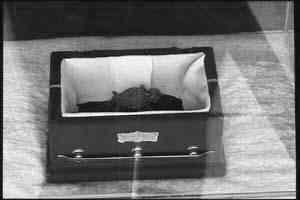|
Regardless
of what you call them - horned lizard, horny toad or horned frog -
you probably don't see many of them these days. Once an almost ubiquitous
part of the Texas landscape and psyche, the horny toad, as they are
most commonly called, has been mighty hard to find for a long time.
You might have some luck on the backroads and the backcountry of West
Texas, but you're not going to find many - if any - in Central
Texas.
Blame pesticides, the loss of harvester ants (the toad's favorite
fare) or the invasion of fire ants, but whatever the cause, horny
toads are as scarce as cheap gasoline.
Aside from the environmental aspects, the dramatic decline in horny
toads represents a loss of part of Texas' heritage. The horned lizard
is the official reptile of Texas, so ordained by the Texas
Legislature in 1993. |
|
|
"I'm
a horned frog from Texas" (NOT Ol'
Rip)
1910 Postcard courtesy rootsweb.com/ %7Etxpstcrd/ |
Few
would call the horny toad beautiful, except maybe in a classic, reptilian
sort of way. They're two-four inches long with a short snout, a flat
body and a short tail. It's squinty-eyed and has a prominent crown
of spines and two enlarged spines in center that look like horns.
When threatened horny toads can puff up to twice their normal size.
The spines have made it the final meal of many an unwitting snake.
If anyone ever tries to dispel the myth that the Texas horned lizard
can not squirt blood out of its eye, do not believe them. It can do
this, and does. Some of us found this out the hard way, after years
of blood-free relations with the critter.
Other than that, they are perfectly harmless. A summer pastime of
Texas children used to be gently stroking the horny toads soft underbelly
until it went into a trance. We called it "horny toad hypnosis."
The state of Texas and biologists call it the Texas horned lizard
and most of the rest of us call it the horny toad, except on
the campus of Texas Christian University in Fort
Worth, which has as its mascot the Horned Frog. It's a horny toad
is what it is.
The Horned Frog designation at TCU has in the past caused a bit of
consternation among the biologically correct, like Lawrence Curtis,
a former director of the Fort Worth Zoo. Curtis crusaded to have the
mascot changed to its proper name but TCU would have none of it.
Dallas Morning News columnist Frank X. Tolbert waded into the
fray and defended the "horned frog" designation against all comers.
Tolbert enlisted the aid of New Mexico poet laureate S. Omar Baker
(often referred to as old S.O.B.) who wrote this little ditty:
"The horny toad, ill-graced but harmless
Is thought by some to be quite charmless
At least he helps eat garden ants up
And does not try to crawl your pants up." |
It's
perhaps a bit ironic that the horny toad has become a threatened species
because the most famous story involving a horny toad concerns its
incredible survival skills. Ol'
Rip, the story goes, survived after being entombed in the cornerstone
of the old Eastland
County Courthouse for 31 years.
When the old courthouse was torn down to make way for a new one in
1928 Ol' Rip blinked a couple of times and eventually tried to scamper
away.
Even some people who saw the incident were skeptical. "I know it happened
because I saw it," one observer said. "I know it didn't happen because
it just doesn't make sense."
"I do not know all the facts in the Eastland story," wrote professor
Sam McInnis of Brownwood's
Daniel Baker College. "From what I know about the story I think that
it is true, because the frog was entombed in sand and rock, and it
is possible for moisture and oxygen to pass through the rock and reach
the frog, and sustain life for an indefinite period of time."
The story got as much coverage, especially in Texas newspapers, as
Charles Lindbergh's flight across the Atlantic Ocean. Ol'
Rip became famous and went on a world tour with his own entourage.
The strain of celebrity did what being entombed for 31 years did not
- it killed him. Ol'
Rip died of pneumonia while on tour in England. |
 |
Ol' Rip lying
in state
Photo courtesy of TXDoT |
In
another irony, Ol'
Rip's celebrity might have helped lead to the demise of horny
toads all over Texas and the Southwest.
For a time, Texas children collected horny toads, sold and traded
them, much like baseball cards. Thousands were bought and sold as
pets and souvenirs. None of them lived nearly as long as Ol'
Rip; most died in captivity. Numbers dwindled.
Then along came fire ants, and the pesticides manufactured to wipe
them out. The fire ants are still here but the harvester ants on which
the horny toads depended are mostly gone. But not forgotten.
|
© Clay
Coppedge
"Letters from Central Texas"
- November
17, 2005 column
Authors' Note:
I was at Fort Hood yesterday and a biologist pointed out to me an
area where there are still horny toads. I wanted to go look, but there
wasn't time. - Clay
Coppedge , November 16, 2005 |
|
|
